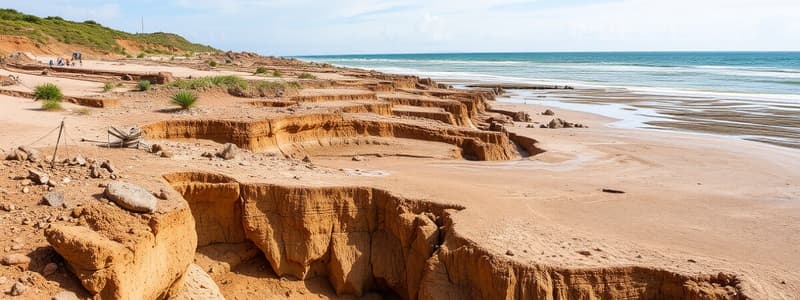Podcast
Questions and Answers
Which agent contributes to erosion?
Which agent contributes to erosion?
- Clouds
- Ice and glaciers (correct)
- Sunlight
- Shorelines
Which factor influences the mass movement of particles?
Which factor influences the mass movement of particles?
- Wind blowing across a body of water
- Addition of vegetation to a slope
- Large rocks and debris on a slope (correct)
- Puddle of water resting on flat land
Which factor most likely facilitates mass movement after heavy rains in a dry region?
Which factor most likely facilitates mass movement after heavy rains in a dry region?
- Deposition
- Weathering
- Mudflow (correct)
- Slump
What role does weathering have in shaping Earth's surface?
What role does weathering have in shaping Earth's surface?
Which phrase describes an example of mass movement?
Which phrase describes an example of mass movement?
Which sediment would have the slowest rate of deposition?
Which sediment would have the slowest rate of deposition?
Sediments are carried from a hilltop to the ground at the bottom of the hill on a windy day. What is the agent of erosion?
Sediments are carried from a hilltop to the ground at the bottom of the hill on a windy day. What is the agent of erosion?
Which event occurs after erosion of Earth's surface?
Which event occurs after erosion of Earth's surface?
How does the substance in a mudflow form?
How does the substance in a mudflow form?
At which point is the slump block located?
At which point is the slump block located?
Flashcards
Agent of Erosion
Agent of Erosion
Ice and glaciers contribute to the erosion of Earth's surface.
Mass Movement Factor
Mass Movement Factor
Large rocks and debris on a slope influence the mass movement of particles.
Mudflow
Mudflow
A mudflow is facilitated by heavy rains in dry regions, involving soil and water mix.
Role of Weathering
Role of Weathering
Signup and view all the flashcards
Mass Movement Example
Mass Movement Example
Signup and view all the flashcards
Rate of Sediment Deposition
Rate of Sediment Deposition
Signup and view all the flashcards
Wind as Erosion Agent
Wind as Erosion Agent
Signup and view all the flashcards
Particle Settling After Erosion
Particle Settling After Erosion
Signup and view all the flashcards
Formation of Mudflow Substance
Formation of Mudflow Substance
Signup and view all the flashcards
Slump Block Location
Slump Block Location
Signup and view all the flashcards
Study Notes
Erosion and Deposition Concepts
- Agents of Erosion: Ice and glaciers significantly contribute to erosion, reshaping landscapes through their movement.
- Mass Movement Influencers: The presence of large rocks and debris on a slope critically influences the movement of particles, increasing the likelihood of mass movement.
- Factors in Dry Regions: After heavy rains, mudflows are the most likely event to facilitate mass movement in dry areas, where saturated soil becomes unstable.
Weathering and Its Effects
- Role of Weathering: Weathering is essential for breaking down older materials into sediments, which contributes to the formation of soils and landscapes.
- Mass Movement Examples: An example of mass movement is soil mixed with water sliding off a cliff, demonstrating the dynamic interaction between water and soil on slopes.
Sediment Characteristics and Behavior
- Deposition Rates: Irregularly shaped sediments have the slowest rate of deposition due to their shape impacting how they settle.
- Erosion Agents: Wind serves as a crucial agent of erosion, transporting sediments from elevated areas to lower ground on windy days.
Post-Erosion Events and Sediment Behavior
- Particle Settling Dynamics: After erosion, very dense particles settle faster than their low-density counterparts, influencing sediment layering and landform development.
- Mudflow Formation: Mudflows form primarily when rain mixes with soil, creating a slurry that can flow rapidly downhill.
Visual Interpretation
- Slump Block Identification: In visual assessments of geological features, pinpointing the location of slump blocks is essential for understanding mass movement dynamics.
Studying That Suits You
Use AI to generate personalized quizzes and flashcards to suit your learning preferences.




